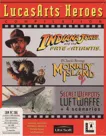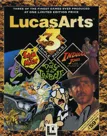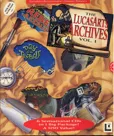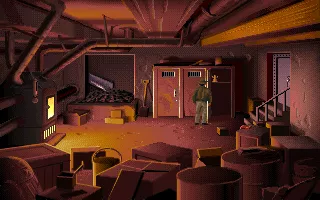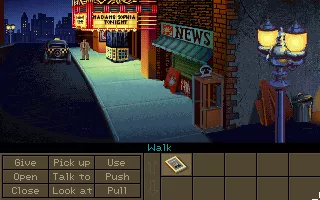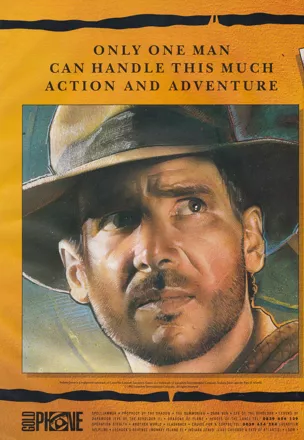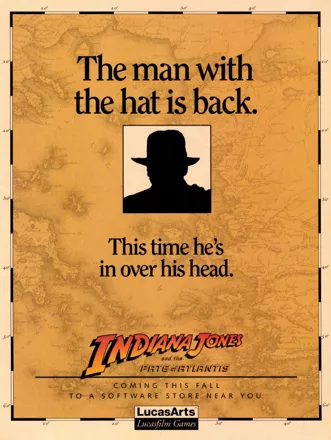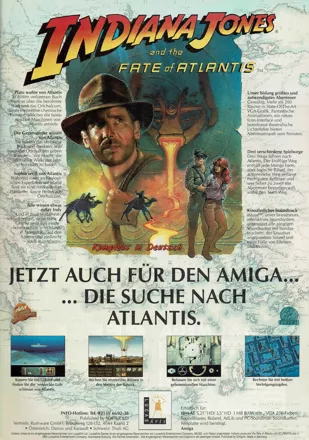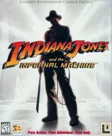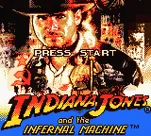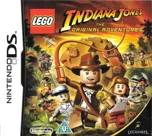Indiana Jones and the Fate of Atlantis
Description official descriptions
Indiana Jones is back! The great archaeologist and adventurer has to solve a grand mystery once again, aided by his trusty whip, his sharp wit, and his courage. A man who calls himself Mr. Smith is interested in a certain ancient statue. When the unsuspecting Indy hands it over to the client, he finds out that Mr. Smith is in fact a colonel in the Nazi army! Why was he so interested in that statue? A young woman who had once worked together with Indy, the pretty red-haired (and a bit troublesome) Sophia, tells him the whole thing must have a connection with the legendary lost continent Atlantis. Gathering clues from all over the world, Indy and Sophia embark on a grand journey across the globe.
Indiana Jones and the Fate of Atlantis is a puzzle-solving adventure game conceived in the spirit of Indiana Jones movies; however, it is not based on a specific movie, introducing a new, independent story. The game utilizes LucasArts' SCUMM system, with action verbs the player chooses from a menu; objects that can be interacted with are highlighted. The game contains many puzzles of various kinds (mostly inventory-based) and dialogues with multiple choices. There are also a few simple hand-to-hand fights against the Nazis, some of which can be avoided.
The middle part of the game can be played in three "modes": co-operation (Indy and Sophia), adventure (Indy alone), and action (Indy alone, with fewer puzzles and more action). In each mode, there are different locations to visit, different puzzles to solve, and different characters to meet. The CD version of the game adds voice-overs to all the conversations.
Spellings
- Индиана Джонс и Судьба Атлантиды - Russian spelling
- אינדיאנה ג'ונס: בעקבות סודה של אטלנטיס - Hebrew spelling
- インディ・ジョーンズ アトランティスの運命 - Japanese spelling
- 印笫安那.瓊斯系列:亞特蘭提斯之謎 - Traditional Chinese spelling
Groups +
- Game Engine: SCUMM
- Gameplay feature: Multiple endings
- Games made into comics
- Games with manual lookup copy protection
- Indiana Jones licensees
- Inspiration: Movies
- Physical Bonus Content: Hint Book
- Physical Bonus Content: Poster
- Protagonist: Female (option)
- Protagonist: Treasure hunter
- Setting: 1930s
- Setting: City - Monaco
- Setting: City - New York
- Setting: Military Submarine / U-Boat
- Software Pyramide releases
- Sound Engine: iMuse
- Theme: Atlantis
Screenshots
Promos
Videos
Add Trailer or Gameplay Video +1 point
See any errors or missing info for this game?
You can submit a correction, contribute trivia, add to a game group, add a related site or alternate title.
Credits (DOS version)
127 People (125 developers, 2 thanks) · View all
| Project Leader | |
| Design | |
| Programming | |
| Interpreter / Development System | |
| Graphics / Artwork | |
| Music | |
| Producer | |
| Playtesting | |
| [ full credits ] | |
Reviews
Critics
Average score: 91% (based on 47 ratings)
Players
Average score: 4.0 out of 5 (based on 440 ratings with 17 reviews)
Best adventure game I have seen.
The Good
Indiana Jones is a legend of its own. Raiders were the first and because of that the movie became legendary. Temple was a mediocre filler and Crusade was a great hit because of a new character portrayed by fabulous Sean Connery. So LucasArts had great material at their disposal to base game upon. But no. It would not be LucasArts if they would not go the other way.
Indiana Jones and the Fate of Atlantis presents a completely new, original story. And it would not be LucasArts if they would not elaborate it. So the story not only is on par with any of the three movies that preceded the game (Crystal Skull was 15 years after this game) but the player's sheer involvement in a brand new Indy story makes this stand above any of the movies. It's pretty hard to explain if you didn't play the game. It's not like a game based on movie which follows the plot and you loose much of the surprise because you know what is supposed to happen. Not when you have a well known character in a brand new story. The game starts with a really great interactive intro with Indy making some funny remarks about Barnett College artifacts. It's this intro that captures you and sucks you into the game which then keeps you in till the very last image and the last tone of the music. Most of people don't like intros but this one is worth spending 10 minutes on, also because it explains the basic setting of the plot.
When I first played the game in 1997 it was already a bit dated. But since I am an oldskool player (and I know the internals of PC) I found the VGA graphics amazing (more so when I learned it was hand painted, every single background, character, movement and animation) and the music (especially Adlib) really captivating despite it was pretty primitive compared to other systems.
But what was really the most thrilling element of the game was the storyline. Starting of with the intro and an action sequence that set the game in motion the game story progressively builds up, Indy reveals more and more about the Atlantis. Nazis are a constant threat in the game (as in every Indy movie) but there is also something more in the air. This doesn't reveal itself till the very last stages of the game (and I will not reveal it either) but the game pacing, settings and music build up this tension as the player approaches the goal. The atmospheric highpoint for me was the Outer ring with its maze, gloomy music and Nazis walking all around where player had to take long distance trips through the maze. It really brought in the frustration and sense of threat that a real human in this setting would experience.
The puzzles are another highpoint of the game. You've got these, let's say eccentric puzzles in Day of the Tentacle or Monkey Island. Not so with Indy. If you want to make a balloon you have to use a real balloon bag, a real basket and something to tie it with. Puzzles like these contribute to the involvement of the player because the player doesn't feel like he's doing something outrageous. One big plus is many of the puzzles (almost all of the important ones) change with each replay - the things needed are hidden in different places, the player is required to use a different approach or a different object, search at different locations or take different steps to complete the objective. A great example of this is a search for Lost Dialogue in the first part of the game where the dialogue can be hidden in several places (I think it's more that five!) and to retrieve the Dialogue from each place takes a completely different set of steps to take.
If changing puzzles are not enough for you then there's something bigger in store for you - three different ways to complete the game. After the first part you make a decision and until the final parts the game progresses totally differently in each mode converging the three paths seamlessly after you reach Atlantis. What is so great about the three modes is that although Indy roughly follows the same locations in each mode (with a host of locations unique to each path) the storyline in each path is distinctively different and locations have different puzzles in each mode that serve different purposes. A topping on the cake of this is that even some characters change from path to path - while they are helpful in one they are evil in another and you never know what to expect or will stand surprised if you try to treat the character the same in different paths. Take the variation in puzzles AND three distinctive paths and you have myriads of possible gameplay combinations that will make you replay the game again and again.
Technically there's not much to say. Controls are so easy you won't be needing manual even in the fighting mode. This is the probably the cleanest most intuitive adventure game interface I've seen. The graphics is a 320x200 256 color VGA mode which was the best you could have on PC those days. Artists at Lucas took some big efforts to make the scenarios look good in this resolution and also make the important elements stand out so that the player doesn't have to do pixel-by-pixel search (except for some two or three occasions).
The music can play either through the PC speaker (no comments needed, you know the bleeps) or using Yamaha's OPL3 music chip found on Soundblaster cards (and clones). For the luckier who had Roland cards the MTU-41 interface was also available. The OPL3 music, although pretty simple stands in its own right and does the job right. First notes you'll hear is of course the obligatory theme (which of course is a positive thing) but the in house musicians created original soundtrack that has his own themes that fit the game and yet is bonded together with the well known Indy theme. Also the ending credits are incredibly well done (I won't spoil what's there) and with the music based on Indy theme rearranged and extended by different original melodies that transition to a grand finale based again on Indy theme with some nice arrangement touches from game musicians finishing with a final crescendo accompanied by a tiny bell sound that will make you smile.
Noteworthy is the iMUSE music system that pretty seamlessly mixes the music according to scenario or situation so that the player experiences a continuous movie-like sound scape that really adds to the game. The voiced version is also a very nice touch since reading silent letters on top of nonsilent music is not really natural, having voices AND music WITHOUT the letters is much more a cinematic experience and takes the player involvement a step further.
Summed up - if you are able to switch your brain to year 1993 play this game if you haven't. The story, atmosphere, technical quality and huge replay value are so attractive you will find enjoying this game more than you would find healthy to. For me the game stands in the adventure genre as a highpoint, as the best adventure game ever.
The Bad
There's not too much bad to say - it IS a best adventure game after all (for me at least). Maybe some parts were too long and frustrating (e.g. the outer ring). Maybe some animations and movements could be better (especially in final scenes where Indy and Sophia are expect to run from Atlantis yet the animations shows them Sunday walking). Also there is this quirk - some sound effects are presented as text (or sampled sound in talkie version) while others are played back through MIDI/OPL3 chip. This might be distracting to some (it was to me) since you never know what you're going to hear/read and it makes some scenes unnatural (like Indy pushing a stuck door, first the text reads "ouch, oof" but nothing is heard and then the doors move and suddenly you can hear the door squeak). This is probably my biggest criticism of this game, apart from that there is really hard to find something bad in this game.
The Bottom Line
A legend in adventure gaming, a must have for anyone who is able to appreciate a game in the context of its age.
DOS · by Mike Spicely (5) · 2009
Licensed title? I didn't hear anybody swear
The Good
(the Bad)
Due to conceptual reasons revealed later on in the review, I have decided to discuss the bad things about the game first.
1) the graphics aren't that good; if you consider that Sierra remade Quest for Glory this same year (and Kyrandia 1 was released as well), the backgrounds in this game just seem grey and dull and unimaginatively photo-realistic (though without such advantages of photo-realism as high resolutions and lots of colors) in comparison. The color palette in this game makes me want to ask a question: why hasn't there ever been a b/w adventure game released, ever? Also, the backgrounds aren't very detailed either, and the characters are pretty small, and mostly with no close-ups either.
2) you could die in this game, and quite easily; what happened to the LucasArts philosophy?
3) upon replaying it recently, I found it kinda short; sure, it has that advantage of having the middle-section in three different versions (you bet I was thrilled when after finishing the game for the first time I suddenly found out that there were practically two more somewhat smaller games there yet remaining) but if you play the whole story through, you get to play only one of those versions, and then you're smack into the last third (more like last half) which is always the same. And the middle-section isn't that long either - only a half-dozen locations (2 very small in Atlantic, 2 not-so-large in the Mediterranian, the large but not-so-exciting dungeons of Crete, optionally a mining site in Africa or a small island near Crete (both virtually unpopulated) and the sub, and that's it) and only a half-dozen characters with more than a couple of sentences to say or a fruit-on-a-stick to give you. I think that if they would've concentrated their efforts on one single definitive middle-section, they would've made a much more fulfilling game - but then again, that is what is always think regarding "non-linearity" in plot-led games.
4) the last section (Atlantis) is extremely questionable. First of all, the graphics go totally down the drain here - it's all a big muddy dungeon. Second, no characters to talk to (which is a big drawback because some comic relief would be very welcome here). Third, most of it takes place in a sort of a maze-like contraption, which thankfully doesn't involve any actual labyrinth-navigating (in fact, the top-down view makes it more like that handheld-game where you have to navigate this little ball through this little maze), but there are soldiers chasing you and it takes a pretty long time to get from anywhere to anywhere. Fourth, the actual gameplay in this section is kinda, er, I think "anal" is the word that describes it best: the thing is that some of the rooms in this maze just HAPPEN to be blocked off in some way (cave-ins, that sort of thing), yet there also just HAPPEN to be some chutes through which you can stick something into that room and knock something over, which just HAPPENS to have the effect of cracking open some door or starting some machine (which just HAPPENED to be standing there) which just HAPPENS to kill the two guards standing in that room. But why did I have to get into those rooms in the first place, I can't help asking (excepting the one which had Sophia jailed in it)? What, is it the ONLY room in the whole world to contain a stick, or a ladder, or some cogwheels I don't even yet know why I need? Have you ever seen an Indiana Jones film where he spends most of his time running back and forth from one room to the next, and to the next, and the next and then back again to the first one to see if the pile of crap he pulled out of the ancient Atlantidian garbage cans in those three "next" rooms just MIGHT switch/break something in the first one? WHY, tell me, why is it that if a robot breaks down in ONE room, his insides end up splattered across the whole goddamn underwater city? Or again, did the ancient super-advanced Atlantidian race have no conception of a "spare parts" shop/"room"/whatever and when something broke down they usually stole replacement parts from the robots/machines in the next room? When a computer at your workplace breaks down, do you usually sneak into the next room and break down your collegue's PC and steal parts from it? Don't answer that question.
And anyway - of course I'm not in any way suggesting that making the maze section even bigger would be a nice design idea (exactly the opposite), but it does occur to me that barely a hundred Atlantidians could fit in that "city", and even then they'd be very uncomfortable, there being no beds/toilet facilities anywhere to be found. And what did they eat anyway? Did they just open the window and fish? I just bet they did, because Indy certainly doesn't have any problem just barging in with his sub and then opening some door and getting inside (no diving gear/contact with water involved at any point). But then again, he doesn't have any problems being fired out of a sub's torpedo launch, so I guess he's just of a hardier stock than most people.
And what's worse (getting back to the mazes), once you get past the first biggest maze-circle and into the second one (smaller), the gameplay suddenly turns into "stand on the back of a mechanic swimming turtle (how aptly chosen!), and wait like 5 minutes until he transports you across the 3 desolate screens to the one which contains, again, a stick or a cogwheel". Then take the express back (I'm speaking ironically here), run across the whole of the bigger outer maze to some room where you can get some freaking beads you need to operate the machine which needs the cogwheel you just found. Look adventure game designers - having makeable/gatherable objects in a game which take a load of repetitive actions to make/gather, and the quantity of which is unlimited and the REQUIRED quantity is unknown (unless you're reading up on the walkthrough as you go along) = WRONG WRONG WRONG! What happened to the Monkey Island rope which you could never burn to the end? If LucasArts wanted to make Indiana Jones and the Legend of Kyrandia, maybe they should've included the option to EAT the goddamn beads by clicking them on yourself as well!
5) the Crete dungeon isn't that hot either; the puzzles are a bit funner here (particularly in the solo brawn version) but the top-down view has been removed and replaced with a regular multiple-screens maze. And the mineral-seeking fish-on-a-string is sure no match for the navigator's head! (Though the cool graphic effect of Indy climbing down a waterfall made up for it. In 1992, that is.)
6) character interaction generally left a lot to be desired: there clearly wasn't much effort put into branching out the dialogues, and aside from very flatly asking for the information that you need ("Have you seen any suspicious people digging around in the desert anywhere around here?"), the only thing Indy does is make some occasional off-hand one-liners ("I'm selling these fine leather jackets") or make some passably funny off-hand "I'm a big oaf" comments about the story ("uh, then they all died?" kinda stuff). There's little or no non-essential (to the plot) speaking going on - esp since Indy's witticisms usually end up with him either boxing with somebody or just plain being killed - which leaves the game world kind of bare, not fleshed out with little details like Sam and Max or Day of the Tentacle.
The Bad
(the Good)
Well. Those there were the drawbacks. The good thing is - this is the best single example of the "traditional", classic graphic adventure game. This is what adventure games where about until their surviving members sought refuge in cartoons (Tentancle, Sam and Max), or (intentional) self-parody (Monkey Island), or horror (Alone in the Dark) or film noir (Grim Fandango) or just simply much much more involved, "serious" stories, dialogues and plots (Gabriel Knight). The conceptual reason I put "the bad" first is this - though I KNOW this game is great, a classic, furthermore a classic I knew to be a classic way before anybody told me it was a classic (because I simply loved it so much when I played it), yet upon replaying this game a couple of months ago, I was unable to pinpoint the reason why I thought it was so great. Therefore I simply am unable to put anything constructive in the "good" section. Suffice to say that the drawbacks I have listed, and the rest is simply a defining chapter in the history of computer games.
But in the way of personal recomendation I CAN say this - when I first played this game, sometime around 1993 and 1994 (I was 12 at the time), I wrote it down as "my favorite game of all time". I hadn't played that many games at the time, but the game Fate of Atlantis stole the crown from was Dune 2, so it does say something. It held the title for about a year, until Gabriel Knight took over (and another year later, Ultima 7, pt 1). And about 7-8 years after I played it originally, I replayed it, and found it to be a mere shell of its former glory - the locations, the puzzles were all there but the magic wasn't. Why? Is it simply because I have come to expect much much more from a game, to expect film or cartoon-quality graphics (and original graphic design), top-class voice acting and witty, involved, surprise-filled dialogues? I guess you could say that I, like most gamers, have become lazy and don't use my imagination anymore (since there is much less need) - to which I would respond, true, but I would also rather prefer to have a modern car/computer/TV/whatever rather than have an old one and "use my imagination to make it come alive". Wouldn't you? And games are no different. If my imagination made the game "come alive", then I should sing praises to my imagination, not to the game. I certainly don't think it's true that games like Fate of Atlantis just gave an inferiour presentation of their content and therefore are now obsolete - I think that they weren't just pieces of mud your imagination made something out of, I think that the games of that time WORKED the imagination, were specifically made FOR the imagination, thus as to excite the imagination, to guide it and so on. Much like games today are made for 3d graphic cards and suchlike - games of that day were made for the imagination, some used it better, more efficiently, some worse. Obviously, Fate of Atlantis used it best of all - but. It doesn't work anymore. The naivette is gone, the belief that this game can "take me places" is gone. I can take the game apart like I couldn't before, I can note all the mechanisms that were supposed to drive the imagination, but they don't actually reach their target. It's as if I could print out some program's source code, read it and imagine how it was supposed to function but couldn't actually run it since it was written for some specific piece of hardware that nobody produces anymore.
There. I've exhausted THAT metaphore.
The Bottom Line
Play this game if you want to find out what was so great about the "classic" adventure game. Play this game if you want to find out why the classic adventure game became extinct.
DOS · by Alex Man (31) · 2002
If I could have only one game, this'd be the one
The Good
There's awfully lot of good memories that tie me to this game, aside from nostalgia, to ever even consider possibility I may like some game more than I like this one from the moment I first played it, back on my Amiga (never did finish it on Amiga, though, was some error in the final scene, rats). Monkey Island had a brilliant artwork and was a classic to consider, with all the elements to attract an average player, Indiana Jones was just a spin-off of a movie. Still, Fate of Atlantis, always considered as Indy IV took a story on its own, and surpassed the movies in almost every possible way. Nazis are still here as Indy's ultimate nemesis, wouldn't be the same without them for our adventurous archaeologist.
This game starts really unique with an opening that is half-gameplay half-cinematic that you may skip with a renowned RMC, but then lose a big portion of fun. Although all the characters beside Indy are new, it was really great to spot Marcus Brody in the opening, if even for a short time (he did look older, though). The hand-drawn graphics is breathtaking and with the most incredible soundtrack will soak you in to the atmosphere so hard you'll start feeling the worlds around you.
The script is well written and with multiple paths and endings that were all so well executed you won't regret a second of replaying the game. Dialogues are witty and on the level of LucasArts' golden era, and voice-acting (assuming you have a CD-ROM version of this game) is superb. LucasArts was/is always the leading game company when it comes to the quality of voice-actors, but this game is simply amazing, not to mention probably one of their first to had a voice-acting in general. The accents were truly amazing.
The Bad
Not one peep.
The Bottom Line
This is a true heart of an adventure game. LucasArts' finest hours, perfect in every aspect. I hardly saw a game that could compete with level of quality and entertainment this one has. Besides, I'm still a die-hard fan of 3rd-person point-and-click graphic adventures, even though they are remnants from the past nowadays. If you consider yourself to be a true gamer, you won't miss this game for anything... though I suppose any true gamer probably already has a copy of this game. The rest of you, go seek perfection in newer games, 'cos to love this game, you gotta have some solid gameplay background to support you.
DOS · by MAT (240793) · 2012
Trivia
1001 Video Games
Indiana Jones and the Fate of Atlantis appears in the book 1001 Video Games You Must Play Before You Die by General Editor Tony Mott.
CD-ROM version
There are two versions of this game: a floppy version (11 disks) and a CD-ROM version. The floppy DOS version features talked interactions for only the introduction, while the CD-ROM one is a full "talkie".
LucasArts Logo Easter Egg
On the island of Crete while exploring the caverns, there are several rooms which have LucasArts logo etched in stone, to look as if they're something that came from Atlantis.
Comics
A Fate of Atlantis comic book series with four issues was published by Dark Horse in 1991. It was based on the story created by Hal Barwood and Noah Falstein, but only loosely followed the game's storyline.
Development
The original script for the game was written by Hal Barwood who also wrote movie scripts for The Sugarland Express (1974), Close Encounters of the Third Kind (1977) and Dragonslayer (1981). He later created the story for Star Wars: Yoda Stories (1997).
For a short period, lead artist Bill Eaken worked at Sierra On-Line, and he hated every second of it. When he did the evil ghost animation at the end of Indiana Jones and the Fate of Atlantis, where it swirls around and comes right up to the player and speaks, he made it say "F**k Sierra."
Fights
You can press Insert during fights to "sucker punch" your opponents and win immediately. Some enemies which can be circumvented by solving a puzzle are immune to this move. To this day this is being reported as a cheat, even though it is a feature of the game and clearly pointed out in the manual (page seven).
This is either a sign of how widely this game was pirated or of how few people actually read manuals.
German version
In the German CD-ROM version a small swastika in Kerner's pass was removed. It is still there in the disk version.
Plot
The story line of this game is fairly accurately based on history. Reichsführer Heinrich Himmler attempted to rewrite history in an effort to prove that the Aryan race in fact descended from the Atlanteans. To this end he instigated archaeological digs in Iceland, the Middle East and Tibet. Similar occult/Nazi material appears in Raven Software's Return to Castle Wolfenstein.
More information about this can be found in the book Himmler's Crusade: The Nazi Expedition to Find the Origins of the Aryan Race.
References
- When you are trying to sell the mask to Omar-Al-Jabbar, one of the things he gives to you is a baseball ball "signed by Lou Gherigh", as he says. But if you look at the ball, it's signed by "Ron Gilbert". Ron Gilbert worked for Lucasarts and was the creator of Monkey Island.
- Several Harrison Ford movies are referenced in FoA. For Example, Indy complains that when he was in school, the principle would always send letters home to his father that began with "Regarding Henry..." (Regarding Harry is a 1991 drama which Ford starred in)
- When Indy plays with the flashlight in the Monte Carlo hotel, one of the shadow puppets is the comic book character Max known from comics and the later Sam & Max Hit the Road.
- In the CD-ROM "talkie" version, when Indiana strains physically he lets out a Wookie roar.
- Many of the street names in Monte Carlo are insider gags. Among other things there is an "Avenue des Troi Bois" and a "Boulevard des Guerres des Etoiles". "Trois Bois" is French for "three wood", which is obviously a reference to Guybrush Threepwood from Monkey Island. "Guerres des Etoiles" translates as "Star Wars".
Awards
- Computer Gaming World
- November 1996 (15th anniversary issue) - #93 overall among the “150 Best Games of All Time”
- November 1996 (15th anniversary issue) – #4 Most Memorable Game Hero (Madame Sophia)
- November 1996 (15th anniversary issue) – #14 Most Memorable Game Hero (Indiana Jones)
- Amiga Joker
- Issue 02/1994 – Best Game in 1993 (Readers' Vote)
- Issue 02/1994 – Best Adventure in 1993 (Readers' Vote)
- GameStar (Germany)
- Issue 12/1999 - #37 in the "100 Most Important PC Games of the Nineties" ranking
- PC Gamer
- November 1999 - #42 Best Game of All Time
- PC Games (Germany)
- Issue 01/1993– Best Adventure in 1992
- Power Play
- Issue 02/1993 – Best Adventure Game in 1992
- Issue 02/1993 – Best Presentation in 1992
Information also contributed by Agent 5, ClydeFrog, game nostalgia, Garcia, Istari, James1, PCGamer77, Rupert Breheny, St. Emydius, Swordmaster, Terrence Bosky and William Shawn McDonie
Analytics
Upgrade to MobyPro to view research rankings!
Related Sites +
-
AmberfishArts - Fate of Atlantis 2 Fangame
Founded in 1998, IndyProject set out to create a sequel to the 1992 LucasArts adventure Indiana Jones and the Fate of Atlantis. FoA2 will resume where the original game ended, and tell its story to the end. It will be a faithful recreation of the feel and atmosphere of the original. -
Game Nostalgia
Provides extensive background info for Indiana Jones and the Fate of Atlantis, pictures of the cast and examples of voice-overs, full credits with shots and info about the design team, demos of the game, specific details about the game, various goodies, all musical themes, shots of every location in the game, saved games, a list of reviews, including a "nostalgic" review and tech specs. -
Hints for Indy - Fate of Atlantis
Jason does it again with wonderful hints for this game. -
Indiana Jones and the fate of Atlantis wallpaper (archived)
A desktop wallpaper for the game. It seems to be a close-up scan of a section of the box cover or manual. -
ScummVM
Get "Indiana Jones and The Fate of Atlantis", as well as many other adventure games, to run on modern systems by using ScummVM, a legal and free program. -
The COMPLETE Indiana Jones and the Fate of Atlantis Walkthrough!
The only 100% complete guide on the web! -
Wikipedia
Talks about technical details of the game, it's history, the making of it, and more. -
iMDB: Indiana Jones and the Fate of Atlantis
General information about the game, including user reviews, ratings, and a message board.
Identifiers +
Contribute
Are you familiar with this game? Help document and preserve this entry in video game history! If your contribution is approved, you will earn points and be credited as a contributor.
Contributors to this Entry
Game added by Olivier Masse.
Windows added by Picard. Amiga added by POMAH. Antstream added by lights out party. FM Towns added by Terok Nor. Macintosh added by Jason Savage. Linux added by me3D31337.
Additional contributors: MAT, Istari, Unicorn Lynx, Jeanne, Apogee IV, Johnny "ThunderPeel2001" Walker, Michael Zöller, CubbyKatz, DarkDante, martin jurgens, Ricky Derocher, 6⅞ of Nine, Paulus18950, Patrick Bregger, mailmanppa, Ingsoc, FatherJack.
Game added October 20, 1999. Last modified April 12, 2024.






